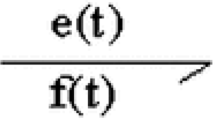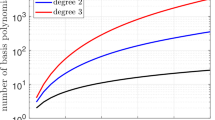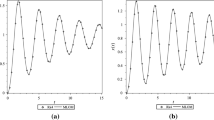Abstract
A bond graph model in an integral causality assignment (BGI) for a singularly perturbed linear time-varying (LTV) system is proposed. The LTV constitutive relations of the elements and MTF and MGY elements modulated by LTV functions of the BGI are considered. A new bond graph called singularly perturbed varying bond graph (SPVBG) for determining the quasi-steady-state model is presented. This SPVBG has the property that the storage elements for the slow and fast dynamics have an integral and derivative causality assignment, respectively. In order to apply the proposed methodology, a case study of an electromechanical system is modelled by bond graphs and approximated models are obtained. Finally, simulation results for the exact and approximated solutions are shown.














Similar content being viewed by others
References
Agultari, C. M., & Peres, P. L. D. (2019). Computing stabilizing output-feedback gains for continuous-time linear time varying systems through discrete-time periodic models. International Journal of Control,. https://doi.org/10.1080/00207179.2019.1612097.
Amato, F., Ariola, M., & Cosentino, C. (2010). Finite-time stability of linear time-varying systems: Analysis and controller design. IEEE Transactions on Automatic Control, 55(4), 1003–1008.
Amato, F., Celenteno, G., & Garofalo, F. (1993). New sufficient conditions for the stability of slowly varying linear systems. IEEE Transactions on Automatic Control, 38(9), 1409–1411.
Batista, Y. N., De Souza, H. E. P., Neves, F. A. S., & Bradaschia, F. (2016). Mathematical modeling of electrical grid current and voltage waveforms for protective relay tests under actual faulty grid conditions. Journal of Control Automation and Electrical Systems,. https://doi.org/10.1007/s40313-016-0259-x.
Borutzky, W. (2011). Bond graph modelling of engineering systems theory, applications and software support. Berlin: Springer.
Chen, M.-S. (1998). A tracking controller for linear time-varying systems. Journal of Dynamic Systems, Measurement, and Control, 120, 111–116.
D’Angelo, H. (1970). Linear time-varying systems: Analysis and synthesis. Boston: Allyn and Bacon.
Dauphin-Tanguy, G., Borne, P., & Lebrun, M. (1985). Order reduction of multi-time scale systems using bond graphs, the reciprocal system and the singular perturbation method. Journal of the Franklin Institute, 319(1/2), 157–171.
Desoer, C. A. (1969). Slowly varying systems \(\dot{x}=A(t)x\). IEEE Transactions on Automatic Control, 14(6), 780–781.
Forbes, J. R., & Damaren, C. J. (2010). Passive linear time-varying systems: State-space realizations, stability in feedback, and controller synthesis. In 2010 American control conference, Baltimore, MD, USA, June 30–July 02 (pp. 1097–1104).
Frih, A., Chalh, Z., & Mrabti, M. (2018). Controllability and observability of LTV systems-bond graph approach. Asian-European Journal of Mathematics, 11(3), 1850038.
Gonzalez, G. (2016). A bond graph model of a singularly perturbed LTI MIMO system with a slow state estimated feedback. Proceedings of the Institution of Mechanical Engineers, Part I: Journal of Systems and Control Engineering, 230(8), 799–819.
Gonzalez, G., & Barrera, N. (2013). Quasi-steady state model determination for systems with singular perturbations modelled by bond graphs. Mathematical and Computer Modelling of Dynamical Systems: Methods, Tools and Applications in Engineering and Related Sciences,. https://doi.org/10.1080/13873954.2013.766214.
Gonzalez, G., & Padilla, A. (2016). Approximate bond graph models for singularly perturbed systems. Mathematical and Computer Modelling of Dynamical Systems, 22(5), 412–443.
Gonzalez, G., & Padilla, A. (2018). Quasi-steady state model of a class of nonlinear singularly perturbed system in a bond graph approach. Electrical Engineering Journal, 100, 293–302.
Gracy, S., Gabin, F., & Kibangou, A. Y. (2017). Strong structural input and state observability of LTV network systems with multiple unknown inputs. IFAC papers OnLine, 50-1, 7356–7362.
Hartung, C., Reibig, G., & Suaricek, F. (2013). Necessary conditions for structural and strong structural controllability of linear time-varying systems. In 2013 European control conference, July 17–19, Zurich, Switzerland (pp. 1335–1340).
Javid, S. H. (1978). Uniform asymptotic of linear time-varying singularly perturbed systems. Journal of the Franklin Institute, 305(1), 27–37.
Javid, S. H. (1982). Stabilization of time-varying singularly perturbed systems by observer-based slow-state feedback. IEEE Transactions on Automatic Control, 27(3), 702–704.
Jetto, L., & Orsini, V. (2009). Relaxed conditions for the exponentially stability of a class of linear time-varying systems. IEEE Transactions on Automatic Control, 54(7), 1580–1585.
Karnopp, D. C., Margolis, D. L., & Rosenberg, R. C. (2016). System dynamics: Modeling, simulation and control of mechatronic systems. Hoboken: Wiley.
Khalil, H. K. (2002). Nonlinear systems. Pentice Hall: Upper Saddle River.
Kokotovic, P. V., Khalil, H. K., & O’Reilly, J. (1986). Singular perturbation methods in control: Analysis and design. New York: Academic Press.
Levinson, N. (1950). Perturbations of discontinuous solutions of non-linear systems of differential equations. Acta Mathematica, 82, 71–106.
Maddalenna, E. T., & Godoy, R. B. (2017). State-space models for assisting loosely coupled inductive power transfer systems analysis. Journal of Control Automation and Electrical Systems,. https://doi.org/10.1007/s40313-017-0354-7.
Okano, R., Kida, T., & Nagashio, T. (2006). Asymptotic stability of second-order linear time-varying systems. Journal of Guidance, Control and Dynamics, 29(6), 1472–1476.
O’Malley, R. E. (1971). Boundary layer methods for nonlinear initial value problems. SIAM Review, 13, 425–434.
Orbak, A. Y., Turkay, O. S., Eskimat, E., & Yocef-Toumi, K. (2003). Model reduction in the physical domain. Proceedings of the Institution of Mechanical Engineers, Part I: Journal of Systems and Control Engineering, 217, 481–496.
Pekarek, S. D., Lemanski, M. T., & Walters, E. A. (2002). On the use of singular perturbations to neglect the dynamic saliency of synchronous machines. EEE Transactions on Energy Conversion, 17(3), 385–391.
Pradeep, S., & Shristava, S. (1988). Some recent results on the stability of linear varying systems. Sadhana, 13(3), 157–167.
Rapisarda, P. (2018). On the identification of self-adjoint linear time-varying state models. IFAC papers OnLine, 51–15, 251–256.
Subbaram Naidu, D., & Calise, A. J. (2001). Singular perturbations and time scales in guidance and control of aerospace systems: A survey. Journal of Guidance, Control, and Dynamics, 24(6), 1057–1078.
Sueur, C., & Dauphin-tanguy, G. (1991a). Bond graph approach to multi-time scale systems analysis. Journal of the Franklin Institute, 328(5/6), 1005–1026.
Sueur, C., & Dauphin-Tanguy, G. (1991b). Bond graph approach for structural analysis of MIMO linear systems. Journal of The Franklin Institute, 328(1), 55–70.
Tchinda, S. F. T., Mpame, G., Takougang, A. C. N., & Tamba, V. K. (2019). Dynamic analysis of a snap oscillator based on a unique diode nonlinearity effect, offset boosting control and sliding mode control design for global chaos synchronization. Journal of Control, Automation and Electrical Systems,. https://doi.org/10.1007/s40313-019-00518-2.
Teixeira, H. T., de Mattos Siqueira, V. S., & Munaro, C. J. (2013). Closed-loop quantification and compensation of friction in an inverted pendulum. Journal of Control, Automation and Electrical Systems, 24, 794–805.
Tikhonov, A. (1948). On the dependence of the solutions of differential on a small parameter. Matematicheskii Sbornik, 22, 193–204.
Tikhonov, A. (1952). Systems of differential equations containing a small parameter multiplying the derivative. Matematicheskii Sbornik, 31, 575–586.
Vasil’eva, A. B. (1963). Asymptotic behavior of solutions to certain problems involving nonlinear differential equations containing a small parameter multiplying the hightest derivatives. Russian Mathematical Surveys, 18, 13–81.
Verhulst, Ferdinand. (2007). Singular perturbation methods for slow-fast dynamics. Nonlinear Dynamics, 50, 747–753.
Wasow, W. (1965). Asymptotic expansions for ordinary differential equations. New York: Wiley-Interscience.
Yang, X., & Zhu, J. J. (2010). A generalization of Chang transformation for linear time-varying systems. In 49th IEEE conference on decision and control, December 15–17, 2010, Atlanta, GA, USA (pp. 6863–6869).
Yao, Y., Sun, D., Balakrishnan, V., & Guo, J. (2012). An integral function approach to the exponential stability of linear time-varying systems. International Journal of Control, Automation and Systems, 10(6), 1096–1101.
Author information
Authors and Affiliations
Corresponding author
Additional information
Publisher's Note
Springer Nature remains neutral with regard to jurisdictional claims in published maps and institutional affiliations.
Appendices
Proof of Lemma 1
Proof. From the second line of (33) with (32)
from the derivative of the fifth line of (33) with (21) and (22)
by substituting (21), (70) and (71) into the first line of (33) with (43),

simplifying (72) with (42) we have
with (38)–(40) and (41), (73) being written by
where
From the second line of (33) and taking (70) with (43),
with (23), (35) and (36), (77) being written by
where
For the steady-state response, \(\overset{\bullet }{x}_{2}=0\) and \(\overset{ \bullet }{x}_{2}^{d}=0\); from (78), the real roots of (34) for the fast dynamics are proved.
From (78) with the linearly independent state variables
and comparing with (8), the relationships between these models are given by
by substituting (81) into (78)
it can be seen that the quasi-steady-state model is determined by \(x_{2}=0\) in (85) with (86)–(88) and (10), (37) being proved.
Proof of Assumptions
1.1 Assumption 4
From the second line of (27)
and
the system will be stable if
the properties for the junction structure are established as
and
by substituting (89) and (90) into (91)
from (92), the stability conditions given in (44) are proved.
1.2 Assumption 5
From the second line of (27) and applying the norm to this expression
this can be written by
from (94) with (45), Assumption 5 is proved.
1.3 Assumption 6
By obtaining the derivative of the second line of (27)
and applying the norm
from (96) and (46), Assumption 6 is proved.
1.4 Assumption 7
By obtaining the derivative of the first line of (27) corresponding to \(A_{12}\left( t\right) \)
and applying the norm to \(\overset{\bullet }{A}_{22}\left( t\right) \) giving
from (98) and (47), Assumption 7 is proved.
1.5 Assumption 8
The derivative of the second line of (27) corresponding to \(A_{21}\left( t\right) \) is
and the norm of this component is given by
from (100) and (48), Assumption 8 is proved.
Proof of Theorem 3
Assumptions 4–7 are equivalent to Assumptions 1–3; then, we can consider a continuously differentiable and bounded linear time-varying system on T modelled by bond graphs (BGI). This BGI represents a LTV system with singular perturbations. Also, the reduced fast model in a bond graph approach is stable according to Assumption 4. Theorem 1 gives the conditions in order to have the result for first-order approximations and Theorem 2 proposes the state approximations for a LTV singularly perturbed system. From (10) with (11) and (12), \(\overline{x_{1}}\) is obtained, in a bond graph approach Lemma 1; from (37) with (38) and (41), \(\overline{x_{1}}\) is determined and (49) is proved.
From the reduced fast model \(\overset{\bullet }{x}_{2}^{f}=A_{22}\left( t\right) x_{2}^{f}+B_{2}\left( t\right) u\), the state \(x_{2}^{f}\) is obtained and from (9) the approximation state for the fast dynamics is got by (20). In a bond graph approach, the model for the fast reduced RFBGI is built by removing the elements, bonds and junctions of the slow dynamics for the complete bond graph (BGI). Hence, RFBGI determines \(x_{2}^{f}\), and from SVPBG and (35) of Lemma 1, (50) is proved.
Rights and permissions
About this article
Cite this article
Barrera-Gallegos, N., Gonzalez-Avalos, G., Ayala-Jaimes, G. et al. Approximate Models of Singularly Perturbed Time-Varying Systems: A Bond Graph Approach. J Control Autom Electr Syst 31, 607–624 (2020). https://doi.org/10.1007/s40313-020-00568-x
Received:
Revised:
Accepted:
Published:
Issue Date:
DOI: https://doi.org/10.1007/s40313-020-00568-x




